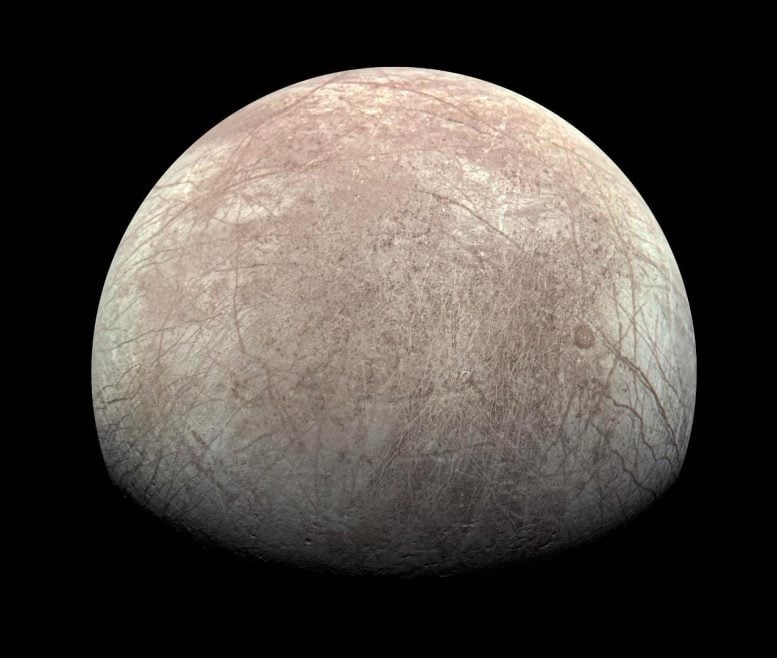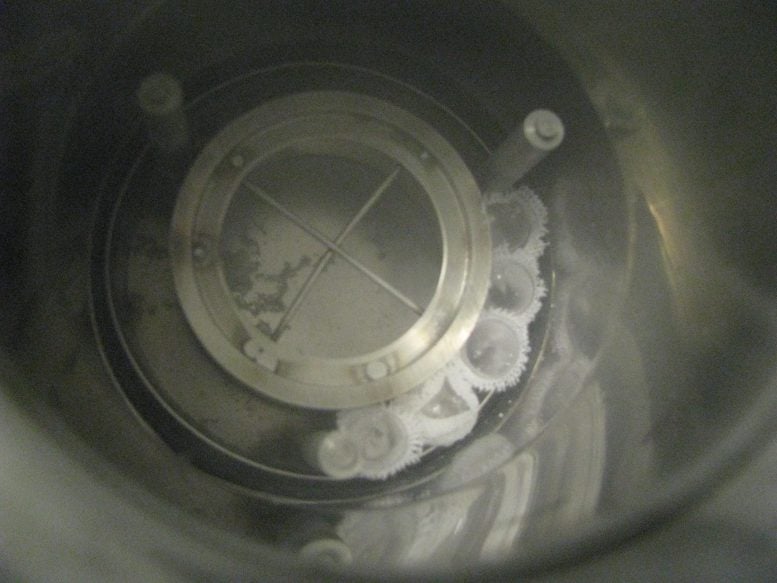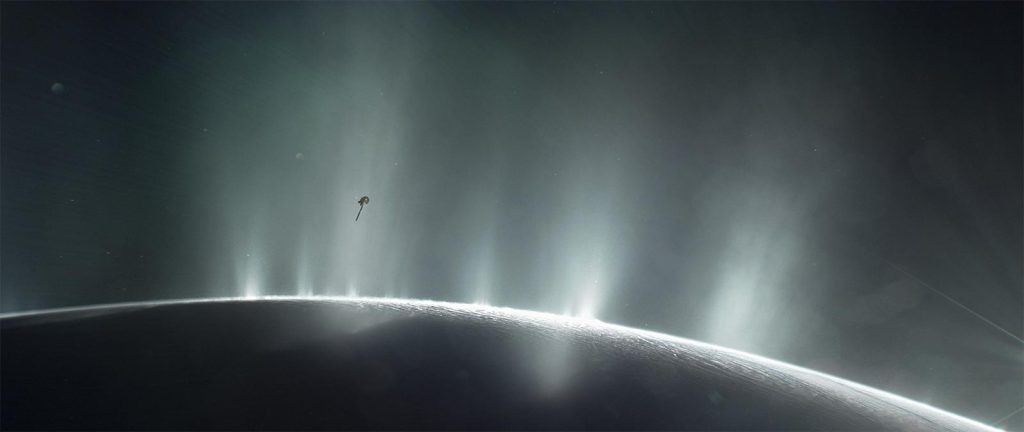This artist’s impression shows NASA’s Cassini spacecraft flying through a plume of water that’s likely erupting from the surface of Saturn’s moon Enceladus. Courtesy of NASA
National Aeronautics and Space Administration (NASA) The researchers: amino acidCould survive near Earth’s surface, a potential indicator of life Europe Enceladus, Jupiter and Saturn Each.
Experiments have shown that these organic molecules can withstand radiation just below the ice, potentially allowing future robotic landers to access them without deep excavation.
Searching for the possibility of life on icy moons
Jupiter’s moon Europa and Saturn’s moon Enceladus have evidence of oceans beneath their icy crusts. NASA experiments have shown that if these oceans support life, then despite the harsh radiation of these planets, traces of life in the form of organic molecules (amino acids, nucleic acids, etc.) may remain just beneath the surface ice. If robotic landers were sent to these moons to look for traces of life, they wouldn’t have to dig very deep to find amino acids that survived without being altered or destroyed by radiation.
“Our experiments suggest that a ‘safe’ sampling depth for amino acids on Europa is about 8 inches (about 20 centimeters) at high latitudes in the trailing hemisphere (the hemisphere opposite the direction Europa moves around Jupiter), in an area where the surface has not been significantly disturbed by meteorite impacts,” said Alexander Pavlov of NASA’s Goddard Space Flight Center in Greenbelt, Maryland, lead author of the study published July 18 in the journal Nature. Astrobiology“Detecting amino acids on Enceladus does not require subsurface sampling; these molecules survive radiolysis (breakdown by radiation) anywhere on Enceladus’ surface, less than a tenth of an inch (less than a few millimeters) below the surface.”

Dramatic plumes of water ice and steam spew from many locations along the famous “tiger stripe” near the south pole of Saturn’s moon Enceladus. Photo credit: NASA/JPL/Space Science Institute
The frigid surfaces of these nearly airless moons are likely uninhabitable due to radiation from both high-speed particles trapped in the host planet’s magnetic field and powerful deep-space phenomena such as exploding stars. But both moons harbor oceans beneath their icy surfaces, heated by gravitational tides from the host planet and nearby moons. These subsurface oceans could potentially support life, provided other essentials such as an energy supply and elements and compounds used in biomolecules are provided.
Experimental approach and results
The team used amino acids in their radiolysis experiments to represent biomolecules on the icy moons. Amino acids can be produced by life or by non-biological chemistry. However, certain types of amino acids may be present on the moons. Europe or Enceladus This could be a sign of life because life on Earth uses proteins as building blocks to make other proteins. Proteins are essential for life because they are used to make enzymes that speed up or control chemical reactions and to form structures. Amino acids and other compounds beneath the ocean floor could be transported to the surface by geyser activity or the slow churning motion of ice sheets.

This image of Jupiter’s icy moon Europa was captured by JunoCam, the public camera on NASA’s Juno spacecraft, during a flyby of Jupiter on September 29, 2022. The image is a composite of the second, third, and fourth images taken by JunoCam during its flight, from the perspective of the fourth image. North is on the left. The image resolution is 0.5 to just over 2.5 miles per pixel (1 to 4 kilometers per pixel). Like the Moon and Earth, one side of Europa always faces Jupiter, and that is the side seen here. Europa’s surface is crisscrossed with cracks, ridges, and bands that erased terrain from about 90 million years ago. Citizen scientist Kevin M. Gill processed the image to enhance color and contrast. Credit: NASA/JPL-Caltech/SwRI/MSSS, Kevin M. Gill CC BY 3.0
To assess the survival of amino acids on these planets, the team mixed amino acid samples with ice chilled to minus 321 degrees Celsius. Fahrenheit (-196 CelsiusThey placed the ice in sealed, airless vials and exposed it to various doses of gamma rays, a type of high-energy light. Because there may be tiny life in the oceans, they also tested amino acids found in dead bacteria in the ice for viability. Finally, to consider the possibility that meteorites or interior materials could mix with the surface ice, they tested amino acid samples mixed with ice and silicate dust.
Implications for future space missions
The experiment provided crucial data for determining the rate at which amino acids break down — the so-called radiolysis constant — which allowed the team to use the age and radiation environment of the icy surfaces of Europa and Enceladus to calculate how deep to drill and where 10% of amino acids would survive radiolysis.
While previous experiments have tested the survival of amino acids in ice, this is the first to use low doses of radiation that do not completely break down the amino acids, as simply modifying or breaking them down would not be enough to determine whether they could be a sign of life. It is also the first experiment to use Europa/Enceladus conditions to assess the survival of these compounds in microbes, and the first to test the survival of amino acids mixed with dust.
The team found that amino acids decompose faster when mixed with dust, but more slowly when derived from microorganisms.

This image shows the experimental samples packed into a specially designed Dewar, which is soon to be filled with liquid nitrogen and placed under gamma irradiation. Note that the flame-sealed test tubes are wrapped in cotton cloth to hold them together. The test tubes become buoyant in the liquid nitrogen and begin to float within the Dewar, preventing proper irradiation. Credit: Candice Davison
“Amino acids are absorbed slowly. acid “The destruction of biological samples under Europa- and Enceladus-like surface conditions strengthens the case for future lander missions to Europa and Enceladus to measure life detection,” Pavlov said. “Our results indicate that the decomposition rate of potential organic biomolecules in the silica-rich regions of Europa and Enceladus is higher than in pure ice. Therefore, future missions to Europa and Enceladus should be careful when sampling the silica-rich sites of both icy moons.”
A possible explanation for why amino acids survive longer in bacteria is Ionizing radiation Radiation changes molecules – directly, by breaking chemical bonds, and indirectly, by generating reactive compounds nearby that alter or break down the target molecule. It is possible that the bacterial cellular material protected the amino acids from the reactive compounds generated by the radiation.
Reference: “Variability and significant loss of diagnostic biomarkers following simulated space radiation exposure in clay- and carbonate-rich areas.” Mars “Analog Samples” by Anaïs Roussel, Amy C. McAdam, Alex A. Pavlov, Kristin A. Knudson, Shelley N. Achilles, Dionysis I. Fustoucos, Jason P. Dworkin, S. Andreykovichova, Dina M. Bauer, and Sarah Stewart Johnson, July 18, 2024, Astrobiology.
DOI: 10.1089/ast.2023.0123
This research was supported by NASA grant number 80GSFC21M0002, the Goddard Space Station Basic Research Work Package from NASA’s Planetary Science Division Internal Scientist Funding Program, and NASA Astrobiology. NfoLD Awarded 80NSSC18K1140.


